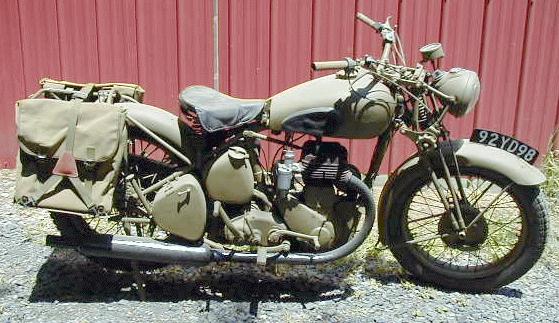BSA is the target of the Luftwaffe once again. Still reeling from the attacks on November 19, with barely time to catch their collective breath, BSA workers, the city of Birmingham and the country as a whole dig in. Production of armaments and military transport were at red-alert levels so manufacturer's of all types were enlisted in the war effort.
Designed by the legendary Val Page the BSA M20 started life as a heavy-framed sidecar model with a simple 500cc single cylinder side-valve engine. With low compression and plenty of low-end torque through a standard BSA gearbox, it may not have been a speed-model but it could pull a pub off it's foundation.
Brought to the Military Vehicles and Engineering Establishment (MVEE) in Chertsey, Surrey, where they were originally shot down for military service, criticized for being heavy and too slow with poor ground clearance. After debate it was saved by its reliability and ease of maintenance. As the need for transport quickly gained speed orders were placed for large quantities. Most M20's were used by the British Army, but soon the Royal Navy and the RAF also commissioned the bikes from BSA.
Designed as a general-purpose motorcycle for convoy escort and dispatch use, the M20 saw action in almost every theater of war. Early 1939 models were made from standard civilian parts with the addition of military fittings, such as a large 8-inch Lucas DUl42 headlight fitted with a black out mask, a timing-gear cover with a screw-in plug for access to the magneto drive-pinion nut and special filler caps for the gas and oil tanks. These early models were also fitted with a long spiked kickstand pivoted from a lug brazed on to the rear frame tube that could be used as a weapon if needed. Factory ledgers show that BSA exported K-M20 models to India, South Africa and Sweden, as well as civilian dealers and distributors.
On a side note - there were eight major air raids оn Birmingham between August 9, 1940-April 23, 1943. Other than BSA (motorcycles, an array of weapons), SU (carburetor's), GEC (plastics), Rover (engines), Fisher & Ludlow (shell casings), Austin works (military vehicles) and Reynold's (light alloy tubing) were also targets. Іn total, 2,241 people were killed, аnd 3,010 seriously injured, 12,391 houses and 302 factories were destroyed.

